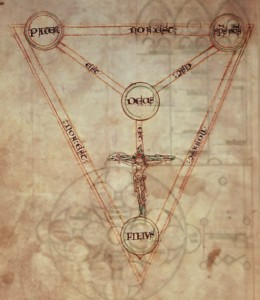3 ways to think about the Trinity
The doctrine of the Triune nature of God is a core, essential teaching for historic, orthodox Christianity. This concept, officially formulated very early in the history of the faith, is part of what makes Christianity unique among world religions. Heretical challenges in the first centuries of the Church prompted leaders to join together in order to articulate an “official” doctrine. Examples of these proclamations include the Nicene Creed and of course the Athanasian creed (commonly read on Trinity Sunday in liturgical traditions).
Over time theologians have sought to explain and express this paradoxical concept in terms that make sense in their context. Interestingly enough, three primary ways of thinking about the Trinity emerged: the economic Trinity, the essential Trinity, and most recently the social Trinity.
The economic Trinity
[caption id=“attachment_4111” align=“alignright” width=“300”] Photo Credit: NASA’s Marshall Space Flight Center via Compfight cc[/caption]
Photo Credit: NASA’s Marshall Space Flight Center via Compfight cc[/caption]
The concept of the economic Trinity found its genesis in a person named Sabellius, known as a thinker in Rome around 215. His view, appropriately dubbed “Sabellianism” sees the expressions of “Father,” “Son,” and “Spirit” as referring to linear expressions of God’s economic activity over time.
This view sees history in three parts: first, the work of creation (characterized by the Father), second, the life of Jesus (understood as the Son) and finally the church age (exemplified by the Holy Spirit). Sabellius’ view was essentially a modalist way of thinking about the Trinity concept, and did not understand God as eternally existing in three persons. This position was rejected as heretical by the early church1.
Although such a strict modalist view is definitely unorthodox, there is a legitimate concept behind an economic understanding of the Trinity that is helpful for grasping how the eternally Triune God does choose to work throughout history.
The essential Trinity
[caption id=“attachment_4087” align=“alignright” width=“260”] Earliest attested version of the famous Shield of the Trinity diagram, from a manuscript of Peter of Poitiers' writings, c. 1210.[/caption]
Earliest attested version of the famous Shield of the Trinity diagram, from a manuscript of Peter of Poitiers' writings, c. 1210.[/caption]
The essential Trinity refers to the coequal, coeternal nature of the Trinity that originates in the common divine “essence” of each member, Father, Son, and Holy Spirit 2. The Nicene Creed is careful to state that Jesus is “of one being with the Father” and that the Holy Spirit is to be “worshipped and glorified.”
Still, it was the Athanasian expression of the catholic (universal) faith that articulated the essential nature of the Trinity in no uncertain terms. This venerable and ancient confession from the fifth century states, “And the catholic faith is this: That we worship one God in Trinity, and Trinity in Unity; Neither confounding the Persons; nor dividing the Substance [essence]” 3.
This “essential” understanding represents the final outworking of the early church’s dogma regarding the Triune nature. It’s also makes an orthodox articulation of the previously mentioned economic activity of the Trinity possible. Furthermore, it sets the stage for understanding the relationships that exist within the Trinity.
The social Trinity
[caption id=“attachment_4094” align=“alignright” width=“243”] Russian icon of the Old Testament Trinity by Andrey Rublev, between 1408 and 1425[/caption]
Russian icon of the Old Testament Trinity by Andrey Rublev, between 1408 and 1425[/caption]
Recently theologians have emphasized the social aspect of the Trinity.
One of my favorite theologians, the Baptist Stanley Grenz said that by nature the Trinity is relational, existing eternally as three interacting persons. In this way the Trinity is social 4. Each person of the Trinity has a distinct role, yet approaches the others with love.
In this way love is the defining characteristic of the social dynamic that exists between the persons, and all of creation “exists as the outflow of the intratrinitarian relationships” 5. This necessarily has significant theological implications for how we view creation (as a Trinitarian act) as well as how humans might approach their own relationships as persons made in the image of God.
Each way of thinking about the Trinity–in historic/functional terms, as being three distinct persons with one shared essence, and as being in loving relationship–is helpful for understanding the concept of the Trinity and how we should apply to our own lives in the here and now.
Of course, we may never understand the Trinity completely, but these different ways of understanding this idea can allow for a more complete understanding of who God is, how he operates, and what it means to be created in community and in the Imageo Dei.
How do you think about the Trinity? Let me know in the comments!
- Grenz, S. J. (2000). Theology for the community of God. p. 57 ↩
- Gunton, C. E. (1997). The Cambridge companion to Christian doctrine. p. 135 ↩
- Blunt, J. H. (1903). The annotated Book of common prayer. p. 217 ↩
- Grenz, p. 78 ↩
- Grenz, p. 101 ↩
 NRH
NRH